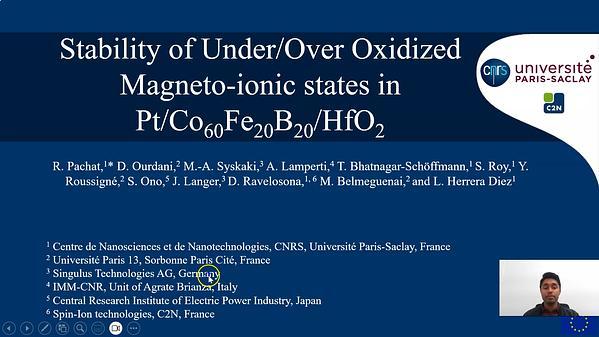Would you like to see your presentation here, made available to a global audience of researchers?
Add your own presentation or have us affordably record your next conference.
Antiferromagnets (AFM) exhibit a host of properties which make them attractive materials for applications. Although they are robust against perturbation by external
magnetic fields, magnetic phases do manifest in bipartite AFMs depending on the applied field and the material properties. The phases are surprisingly complex even in the small particle
limit where the individual lattices are uniformly magnetized. While previous work 1,2,3,4,5 has examined similar systems and determined some of the equilibrium states, this work
comprehensively identifies all critical energy points (local minima, local maxima, saddle points) under the macrospin model 6 where the energy is composed of an applied field (h0)
aligned with a uniaxial anisotropy (hk) mediated by a spatially homogeneous AFM exchange (he). Both easy axis (hk>0) and easy plane (hk<0) cases are considered.
In this analysis eleven candidate magnetization configurations are identified as critical energy states. Six of these are shown to be local energy minima (metastable) for some range of
material and field parameters, illustrated in the Fig. 1 phase diagram. Note the bi- and tristable regions in this diagram that can support hysteretic behavior. The lowest energy (ground)
states, representing long-term stable phases in the presence of thermal effects, are presented in Fig. 2. Saddle points identified by this analysis determine the energy barrier between local
minima and can be used to estimate the time scale for thermally activated switching.
The transition between phases driven by changing h0 is also studied, including in particular the well-known spin-flip and spin-flop behaviors 7. Consideration of energy levels in this analysis shows that of the eleven candidate phases alluded to above, the five which are never local energy minima also do not occur during adiabatic phase transitions.
References
1) F. B. Anderson and H. B. Callen, Phys. Rev., 136, p. A1068 (1964).
2) N. Yamashita, J. Phys. Soc. Jpn., 32, p. 610 (1972).
3) A. N. Bogdanov and U. K. Rößler, Appl. Phys. Lett., 89, p. 163109 (2006).
4) A.-V. Plamadă, D. Cimpoesu and A. Stancu, Appl. Phys. Lett., 96, p. 122505 (2010).
5) H.-F. Li, npj Comput. Mater., 2, p. 16032 (2016).
6) V. Baltz, A. Manchon, M. Tsoi, Rev. Mod. Phys., 90, p. 015005 (2018).
7) N. Ntallis and K.G. Efthimiadis, Comput. Mater. Sci., 97, p. 42 (2015).

Fig. 1: Phase diagram for energetically stable (local energy minima) configurations in an AFM. SFO (spin-flopped) is an easy-axis canted phase. All parameters and fields are scaled by he, denoted by a bar on top.

Fig. 2: Phase diagram for energetically preferred configurations (global energy minima). All parameters and fields are scaled by he, denoted by a bar on top.
